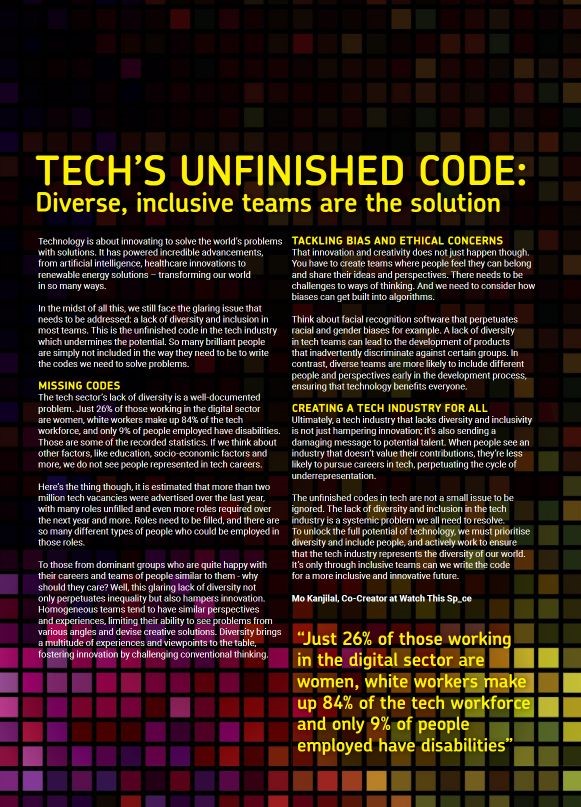A shorter version of this article originally appeared in Platinum Business Magazine
Technology is about innovating to solve the world’s problems with solutions. It has powered incredible advancements, from artificial intelligence, healthcare innovations to renewable energy solutions, transforming our world in so many ways. In the midst of all this, we still face the glaring issue that needs to be addressed: a lack of diversity and inclusion in most teams. This is the unfinished code in the tech industry which undermines the potential. So many brilliant people are simply not included in the way they need to be to write the codes we need to solve problems.
Missing Codes
The tech sector’s lack of diversity is a well-documented problem. Just 26% of those working in the digital sector are women, white workers make up 84% of the tech workforce, only 9% of people employed have disabilities. Those are some of the recorded statistics. If we think about other factors, like education, socio-economic factors and more, we do not see people represented in tech careers. Here’s the thing though, it is estimated that more than 2 million tech vacancies were advertised over the last year, with many roles unfilled and even more roles required over the next year and more. Roles need to be filled, and there are so many different types of people who could be employed in those roles.
To those from dominant groups who are quite happy with their careers and teams of people similar to them – why should they care? Well, this glaring lack of diversity not only perpetuates inequality but also hampers innovation. Homogeneous teams tend to have similar perspectives and experiences, limiting their ability to see problems from various angles and devise creative solutions. Diversity brings a multitude of experiences and viewpoints to the table, fostering innovation by challenging conventional thinking.

Convincing Business Case
There are numerous studies, research papers, government-funded white papers, books, podcasts, videos, stories and more that all point to the obvious business case. As well as being the right thing to do, diverse and inclusive teams output 19% more innovation and 36% higher profits. Add to this better decision-making, higher productivity, stronger employee culture where people want to stay and work, and you can see why this should matter to everyone.
To solve problems, create innovative solutions and create teams where people want to stay, work and contribute, leaders need to think about who is missing from their teams. Your innovative competitors will do exactly that. Smart companies include different people, perspectives, skills and working styles. Those who don’t include different types of people and perspectives will be left behind.
When we talk about inclusive teams, there are so many perspectives to consider. We need to include more women, people from different ethnicities, those with disabilities and those who are neurodiverse. We also need to think wider about those without the traditional education path, people who have had a career break for whatever reason. These are all people who can develop careers in tech and can be trained to be effective in those many vacancies in the tech industry.
Innovation Through Inclusion
Innovation is about identifying and solving global challenges. To address problems such as climate change, healthcare challenges, ageing population, and food security, we need creative solutions. Diverse and inclusive teams are better equipped to tackle these issues, bringing different ideas and perspectives. .
Consider healthcare technology, where a diverse team might consider the unique challenges faced by different communities. They can develop solutions that are not only technically advanced but also culturally sensitive, ensuring that these technologies are accessible and effective for all. This inclusion-driven innovation is essential in creating tech solutions that have a real-world impact.
Innovative companies recognise this and actively seek diversity in their teams to drive fresh ideas. Diverse teams lead to richer discussions, debates, ideas and solutions that push boundaries and exceed expectations.
Tackling Bias and Ethical Concerns
That innovation and creativity does not just happen though. You have to create teams where people feel they can belong and share their ideas and perspectives. There needs to be challenges to ways of thinking. And we need to consider how biases can get built into algorithms. Think about facial recognition software that perpetuates racial and gender biases for example. A lack of diversity in tech teams can lead to the development of products that inadvertently discriminate against certain groups. In contrast, diverse teams are more likely to include different people and perspectives early in the development process, ensuring that technology benefits everyone. .
Creating a Tech Industry for All
Ultimately, a tech industry that lacks diversity and inclusivity is not just hampering innovation; it’s also sending a damaging message to potential talent. When people see an industry that doesn’t value their contributions, they’re less likely to pursue careers in tech, perpetuating the cycle of underrepresentation.
By actively promoting diversity and inclusion in tech, we create an industry that welcomes talent from all walks of life. We signal to the world that innovation is not reserved for a select few but is open to anyone with the drive and passion to contribute.
The unfinished codes in tech are not a small issue to be ignored. The lack of diversity and inclusion in the tech industry is a systemic problem we all need to resolve. To unlock the full potential of technology, we must prioritise diversity and including people, and actively work to ensure that the tech industry represents the diversity of our world. It’s only through inclusive teams can we write the code for a more inclusive and innovative future.
Platinum Media Group are one of the sponsors of Sussex Tech Week June 3rd – 5th 2024
